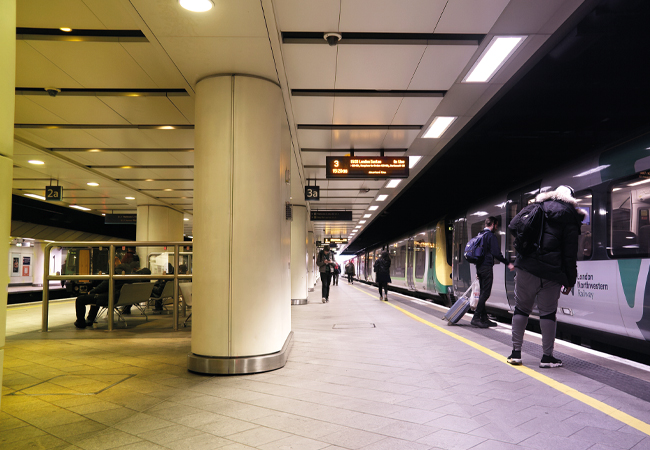
The construction industry has long focused on operational carbon, but has not often considered emissions related to the other life-cycle stages of building services products and equipment.
As much as half of the life-cycle carbon emissions from buildings comes from embodied sources, such as manufacturing of materials and construction processes.
In retrofits, building services accounts for 40-70% of embodied carbon emissions and 15-20% in new build. In the electrical category, LED lighting makes up the highest proportion of embodied emissions1. To make well-informed decisions, engineers and designers need to embrace whole life embodied carbon emissions and educate the client.
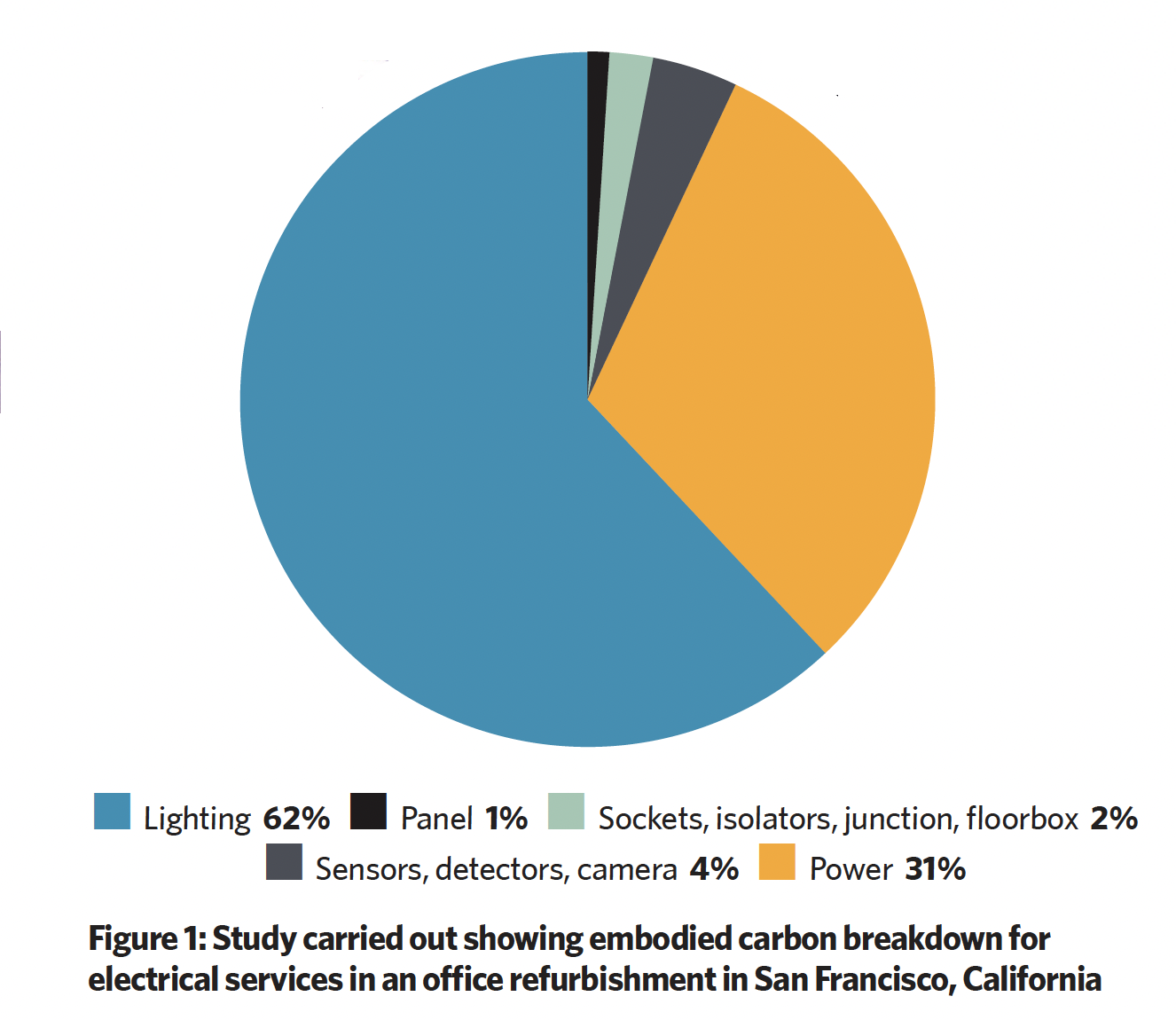
Whole life carbon assessment has five main components and is divided into A, B, C and D sections, as explained in Figure 2. It is the carbon emitted in the whole life-cycle of a component. Embodied carbon does not incorporate the carbon in the operations and beyond life-cycle categories.
In a recent refurbishment scheme at New Street station in Birmingham, Network Rail – along with its sustainability consultant Q Sustain – aimed to minimise the embodied carbon emissions resulting from the replacement of fluorescent lighting with LEDs on 12 platforms. This was the first time that the minimisation of embodied carbon was made a key requirement by Network Rail in an enhancement and renewal scheme.
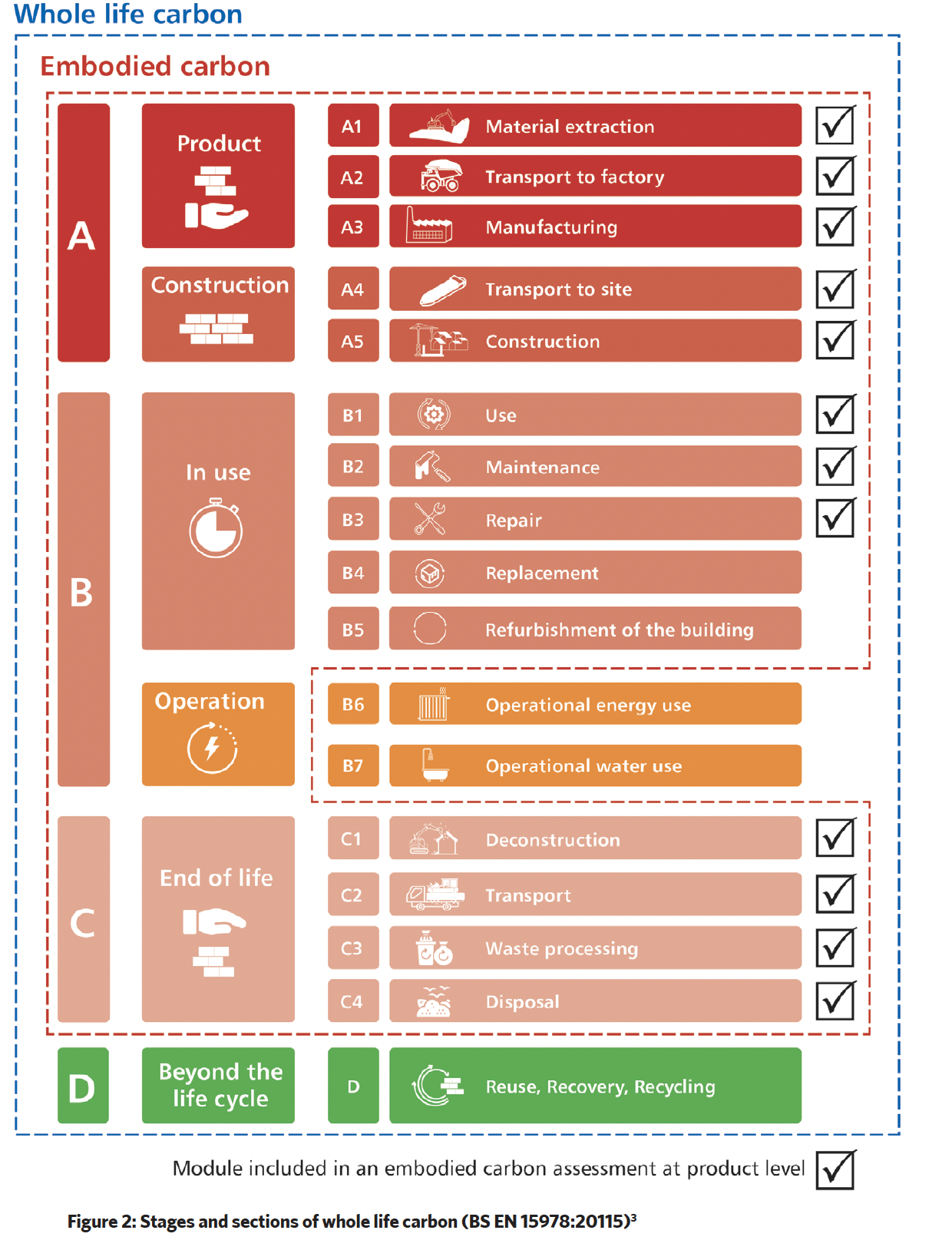
Q Sustain calculated the embodied energy savings of reusing luminaires and replacing the gear trays – the container that holds the electrical components protecting them from dust and moisture. The project team calculated that 163 tonnes of embodied CO2e would be saved.
The reduction in operational carbon as a result of using LEDs was also significant, with an estimated 67 tonnes of CO2e saved every year.
Calculations for embodied energy were based on the calculation methodology in TM65 Embodied carbon in building services2. It assesses the embodied carbon across the whole life-cycle of the product, which includes raw materials extraction, manufacturing, repair and disposal.
TM65 calculation methodology
The TM65 document for each luminaire provides the proportionate material distribution in percentage (at least 95% is needed to be known). This is used in calculating the weight of each material in the product. See Figure 4 for components of a luminaire.
Using the following embodied carbon coefficients, the embodied carbon (EC) of each material is found in kgCO2e by simple multiplication of material weights and their carbon coefficients. The sum of the above EC values gives the value of A1* (EC for the material of the product).
The CIBSE TM65 guide says if there is no specific information from the manufacturer on repair or replacement of components within the product lifetime, a standard assumption of a 10% increase in weight should be used. So, this is (0.1x A1*). The total A1, therefore, is, (A1 = A1* + 0.1A1*). Luminaires come under the category 2 of ‘Medium’ complexity and hence have the scale-up factor of 1.4. This scale-up factor is to account for A2 (transport to factory), A3 (manufacturing), A4 (transport to site), C2 (transport to waste processing), C3 (waste processing) and C4 (disposal). So, the total A1 is now multiplied by 1.4.
Any EC related to refrigerant is added at this step. However, there is no refrigerant involved with the luminaire. Buffer Factor is used to account for the simplicity of this method of calculation. This is 1.3 and is multiplied to the above calculated total (A1x1.4). As a result, we get our value of total embodied carbon associated with the product.
- TM65 is available at www.cibse.org/knowledge
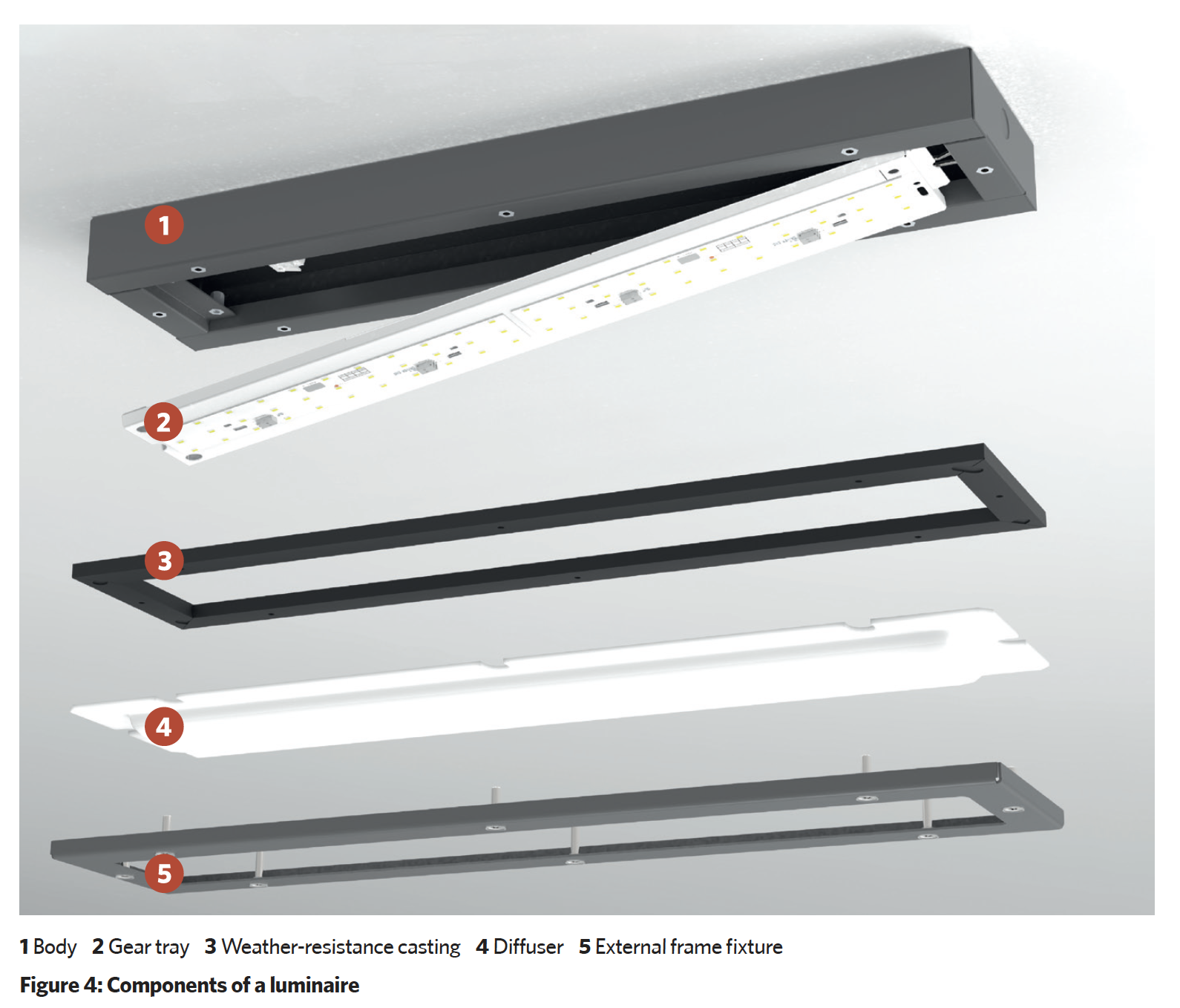
This method focuses on the embodied carbon of a product rather than a system or a building. This is based on information provided within an Environmental Product Declaration (EPD); however, such documents and information are not always available from suppliers.
At New Street, data supplied by Designplan Lighting, the manufacturers of the upgradeable flair luminaire, enabled the project team to calculate the savings in embodied carbon (kgCO2e). It provided information relating to the product’s weight per material type and service life, as well as a breakdown of all the components, with their production location and energy use.
All change at New Street
A major redevelopment of Birmingham’s New Street station took place between 2009 and 2015. The platform works were an early part of the redevelopment, when LED lighting was in its infancy and not installed. Therefore, this project has redesigned the platform lighting from T5 and T8 Fluorescent (at the time) to LED without having to replace the whole fitting (see Figure 3).
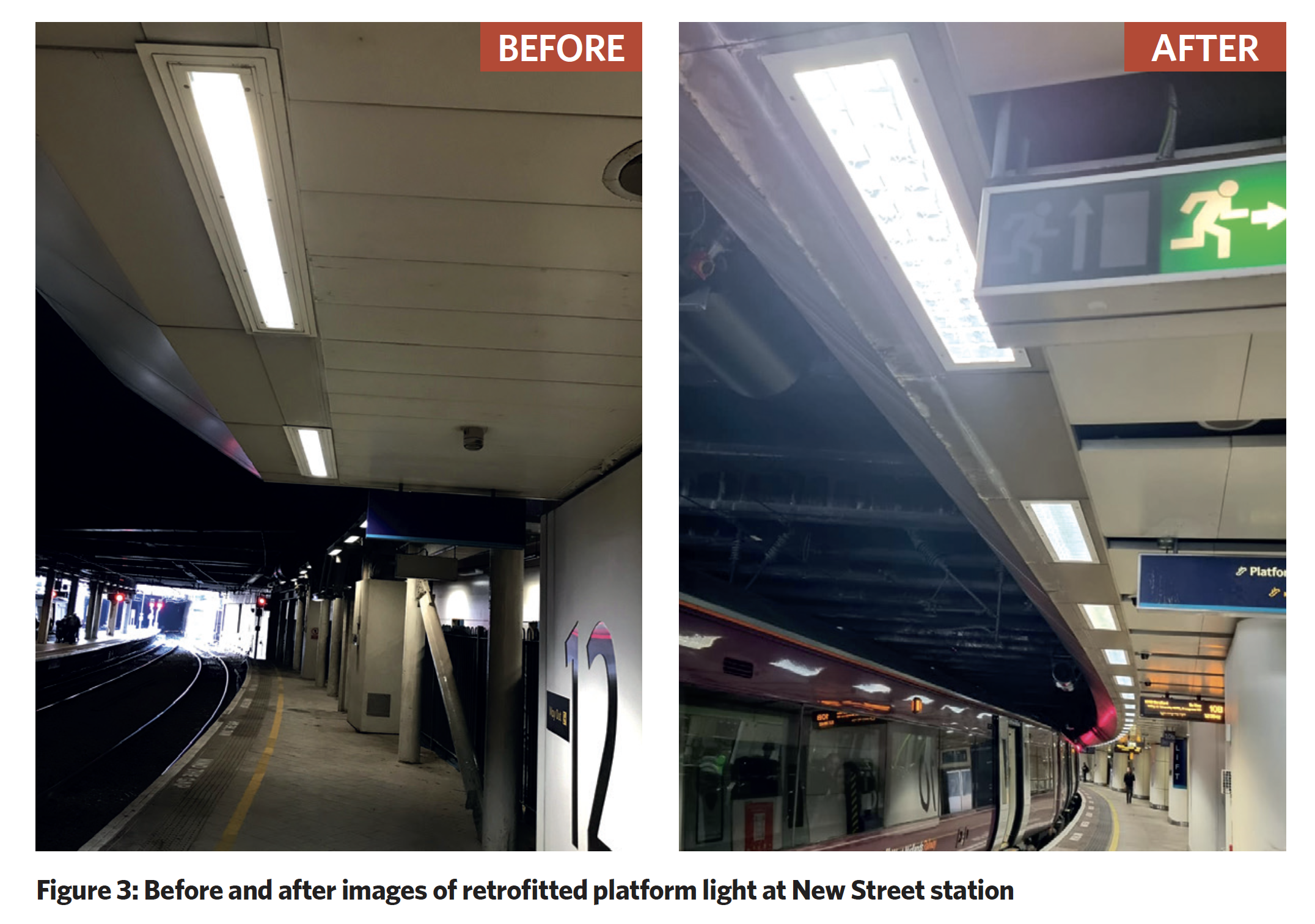
The original luminaire was designed and installed to a high quality to allow future upgradability, so it can sustain a long life and save on long-term costs and embodied carbon, avoiding replacement of complete new luminaires.
We identified that we would be able to save considerable embodied carbon, as well as operational carbon, by replacing the gear trays instead of all 891 complete luminaires across 12 sub-surface platforms, while retaining the original equipment manufacturer-supported luminaire United Kingdom Conformity Assessment (UKCA) status. The approach would also be much cheaper.
Following detailed discussions with Q Sustain, Designplan Lighting developed a retrofit option that replicated, but improved upon, the original lighting scheme. This included a special diffuser, which controlled glare, improved visual comfort, and minimised potential carbon emissions and time spent on a longer installation of a complete luminaire replacement.
To measure the embodied carbon saved, Q Sustain calculated the embodied carbon associated with a new fitting similar to the originals. A retrofit of the following three luminaire types was undertaken at Birmingham’s New Street station platforms (see panel,
Luminaires at New Street
Fitting 1 – 2x28W T5 narrow body – 91 no.
Fitting 2 – 2x36W T8 narrow body – 130 no.
Fitting 3 – 2x36W T8 wide body – 670 no.
For the methodology of calculating ‘basic’ embodied carbon, as stated within CIBSE TM65, see the panel ‘Calculation methodology’.
Using the methodology, the total embodied carbon (kgCO2e) for the three luminaire types is: Fitting 1 – 18,342; Fitting 2 – 25,866; Fitting 3 – 118,584.
So, the total embodied carbon associated with the light fittings is 18,342 + 25,866 + 118,584 = 162,792 kgCO2e = 163 tonnes of CO2e.
Each time we retrofit a luminaire body with the gear tray, therefore, we are saving 163 tonnes CO2e of embodied carbon that would have been emitted if we had used a new luminaire (minus the gear tray). This works out at 39% of whole life carbon emissions – a significant saving.
Along with the carbon savings, the decision to retrofit gear trays of the luminaires has other benefits, including operational and energy savings. These are significant when you consider that 61% of the carbon emissions of a luminaire are operational (Figure 5).
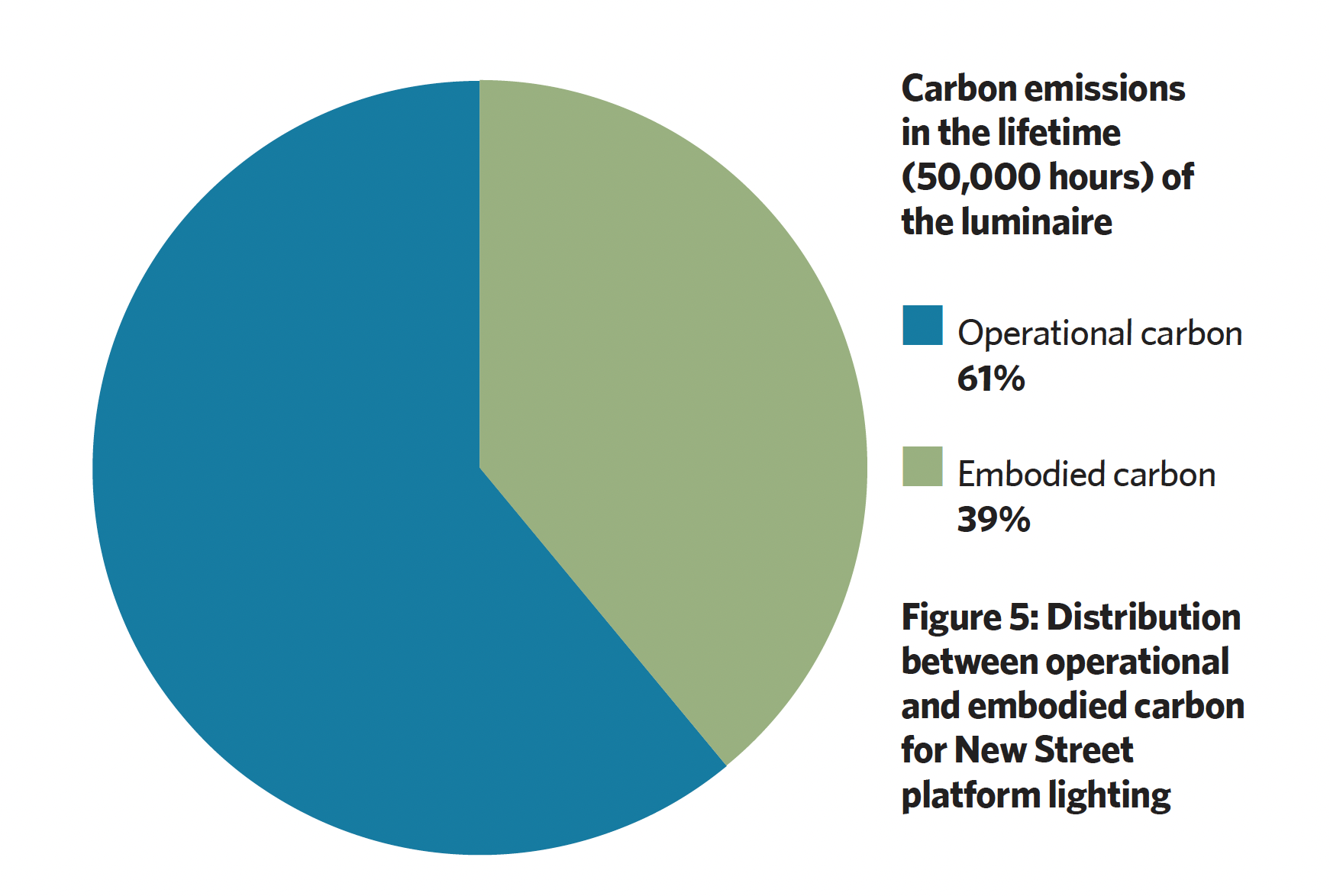
Operational and energy savings
The older light fittings had an average energy point of 70W/fitting, whereas, with the new LED retrofit, the power wattage at each point is reduced to 30W. So, a power saving of 40W is achieved on each light fitting. As the luminaires are operational for 24 hours per day throughout the year, operational energy now consumed is (30x24x365 = 264kWh per luminaire). Using the Carbon factor for electricity in the UK (revised in January 2022), we can calculate the carbon associated with the energy use, which gives the carbon emissions to be 56kgCO2e every year per luminaire.
So, the total operational carbon emission for 891 luminaires is 50 tonnes CO2e every year compared with 117 tonnes with the existing luminaires. The total operational carbon saved by the LED retrofit luminaires, therefore, is 67 tonnes CO2e every year (see Table 1).
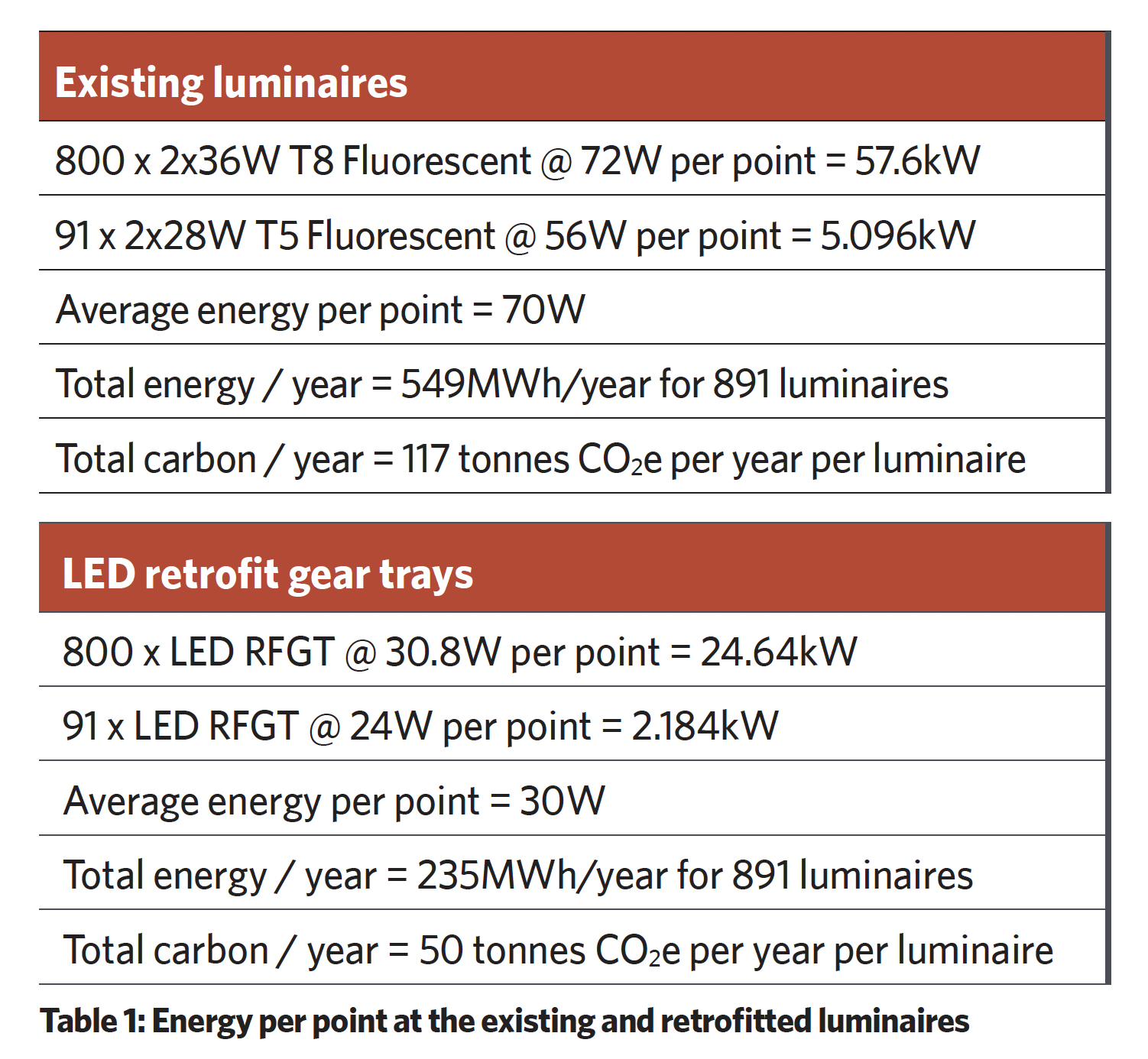
This means that, typically, the return on investment will be two to four years when upgrading. This can be reduced further when using a retrofit gear tray, as less of the original installation needs to be replaced.
Other benefits
The adoption of LED lighting from fluorescent lamps benefits from the high light output per watt of electrical power consumption, known as the ‘luminous efficacy’. For example, the fluorescent luminaire, SPEC – 264551 at the platforms, improved on its efficacy from 44 lumens per watt to 112.28 lumens per watt with this retrofit.
So, the luminaires had a 150% increased light output for every unit of energy: greater output at higher efficiency.
Designplan made sure that the retrofit gear tray was fully tested and met all the requirements of UKCA, to ensure the full luminaire is fit for purpose.
The retrofit means that maintenance costs will be lower in future, as the LED gear trays have up to five times the operational life of fluorescent, reducing maintenance times. The disruption was also minimal, as the new LED gear tray could be fitted via a simple screw-type fused connection.
Replaceable gear trays offer one more valuable benefit – they provide access to new technologies as they are developed, meaning lighting will have a 30-year-plus design life4.
Assumptions
This paper has made the following assumptions and has the following limitations:
- It is assumed that a new fitting would be of the same type as the old fitting
- The gear tray has not been included in the embodied carbon calculations
- A standard assumption of a 10% increase in weight was used for the luminaire replacement over the product life-cycle, in accordance with CIBSE TM65, where data is not available
- The granular components that form part of the luminaire have not been considered, but the fitting as a whole is used in the calculations provided by the manufacturer
- The basic method of calculation has been used with the buffer factors of 1.3, in accordance with CIBSE TM65
- Supply chain information is inconsistent and, therefore, product passports (EPDs) should be compared with checks and balances in TM65
- Retrofitting gear trays and perishable elements within a luminaire are reliant on the luminaire design being suitable
- Any luminaire that is specified with the intention of a future gear-tray retrofit should be robust enough in body to last 30 years+ in order to be sustainable and maintain its quality and integrity.
About the authors
Lovely Chavan is a graduate consultant and Yara Bekdache is a sustainability specialist, both at Q Sustain. The paper was checked and approved by Azhar Quaiyoom, director and CEO at Q Sustain
References:
- ‘Getting to grips with whole life carbon’, CIBSE Journal, 2022. [Online]. Available:
bit.ly/CJMar23NS1 [Accessed: 10 Aug 2022] - TM65 Embodied carbon in building services: calculation methodology (2021) (pdf) | CIBSE, Cibse.org, 2021. [Online]. Available: bit.ly/CJMar23NS2
- British Standards Institution (BSI): Sustainability of construction works. Assessment of environmental performance of buildings. Calculation method, BS EN 15978, 2011
- LED retrofit gear trays for cost-effective technology upgrades, Designplan Lighting, 2022. [Online]. Available: bit.ly/CJMar23Em4 [Accessed: 10 Aug 2022]
